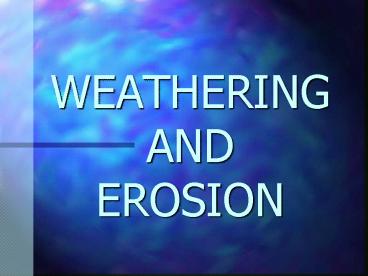WEATHERING AND EROSION - PowerPoint PPT Presentation
1 / 27
Title:
WEATHERING AND EROSION
Description:
WEATHERING AND EROSION Processes that change the surface of the Earth Mechanical or Physical Weathering Chemical Weathering Erosion Tectonic Activity (volcanoes ... – PowerPoint PPT presentation
Number of Views:1055
Avg rating:3.0/5.0
Title: WEATHERING AND EROSION
1
WEATHERING AND EROSION
2
Processes that change the surface of the Earth
- Mechanical or Physical Weathering
- Chemical Weathering
- Erosion
- Tectonic Activity (volcanoes, earthquakes.etc.)
3
(No Transcript)
4
COMMON NATURAL FORCES OF CHANGE
- Wind
- Water
- Plants
- Animals (including humans)
5
(No Transcript)
6
MECHANICAL WEATHERING
- Rocks and other materials break apart via
physical means - similar to physical changes in
chemistry - Chemical makeup stays the same
- wind, burrowing animals, plants, ice
7
(No Transcript)
8
CHEMICAL WEATHERING
- Chemical reactions on the surface breakdown or
dissolve the minerals in the rock or other
material - similar to chemical changes in
chemistry - The chemical makeup changes
- acid rain, oxidation (rusting), plant acids,
lichen, carbonic acid (caverns)
9
(No Transcript)
10
EROSION
- Process by which weathered materials are carried
away - water, wind, ice, gravity, humans
- water is the MOST significant force of erosion
11
(No Transcript)
12
(No Transcript)
13
RIVERS
- Begin as rills gtgt gullies gtgt streams gtgt rivers
- Deposit sediment as they lose energy - slow down
- Form deltas when they reach seas, oceans, gulfs,
lakes
14
Rivers cont.
- Create V shaped valleys
- Colorado River carved out the Grand Canyon over
millions of years - As they age the meanders increase and oxbow lakes
may appear
15
Rivers cont.
- Important to human activity
- Develops rich fertile soils
- Can be very destructive
- Provide recreation and challenges
16
(No Transcript)
17
MASS WASTING OR MOVEMENT
- Gravity is the force behind mass movement
- Landslides, mudslides, slump, creep
- Water, lack of vegetation, steep slopes can
create conditions that are ripe for mass movement
18
(No Transcript)
19
WIND
- Causes abrasion - sand and small particles polish
and smooth jagged edges - Reshapes the landscape - sand dunes
- Can be very destructive - reach speeds over 100mph
20
(No Transcript)
21
GLACIERS
- Create U shaped valleys - Yosemite National
Park - Sharp mountain peaks called Horns, Glacier Lakes
(Minnesota, Great lakes) - Move HUGE masses
- Studied to learn about current and past climate
changes
22
(No Transcript)
23
DAMS Pros and Cons
- Displace people
- destroy habitat
- interrupt fish migration
- endanger wildlife
- change flow of sediments and rivers
- Prevent flooding
- generate energy
- create lakes, reservoirs
24
(No Transcript)
25
Human Activities
- Land Developing - housing, industry, farming
- Mining of Resources
- Damming of Rivers
26
(No Transcript)
27
Weathering and Erosion are processes that
continue on a non stop basis.































